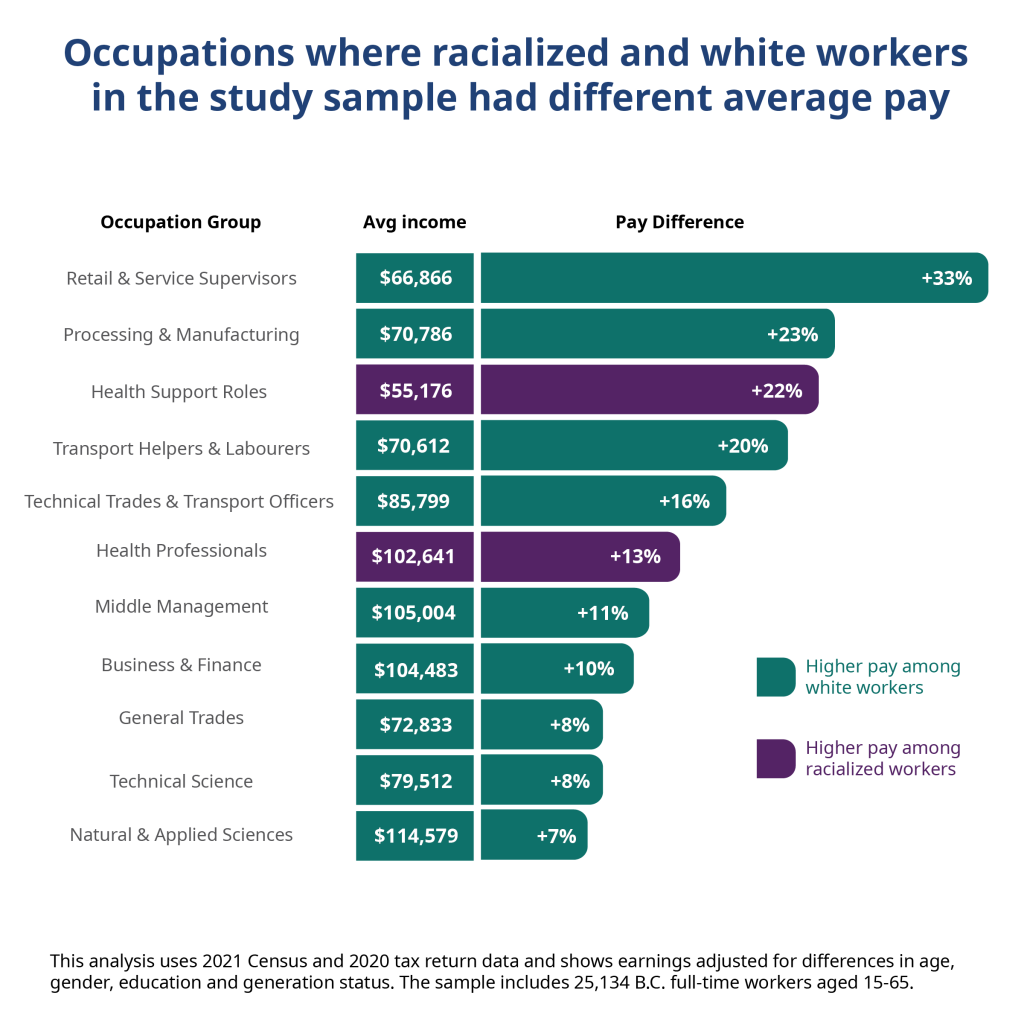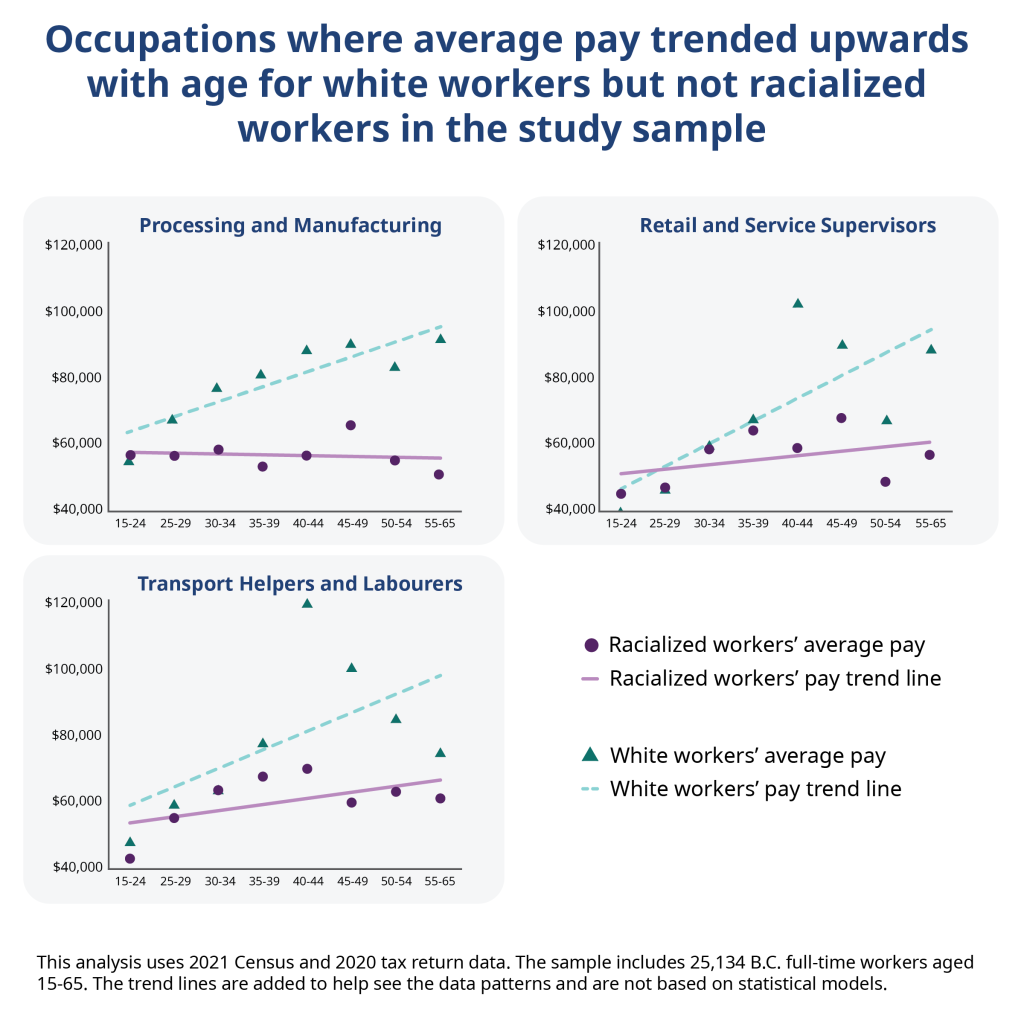Making wages fair for everyone
May 30, 2025

Historically, racialized people have experienced barriers to participating in the economy. Racist policies and systemic issues have impacted their ability to work in certain professions, have their credentials recognized or own property or businesses in B.C.
These barriers are still present today as racialized workers in B.C. are often paid less than white workers. It’s even harder for racialized workers who are women to get fair pay, as shown by B.C.’s Pay Transparency Report.
As government, we want to build a province where everyone is paid fairly for the work they do.
The research
In 2023, the Province, in collaboration with the Anti Racism Data Committee and Indigenous Peoples identified 10 anti-racism research priorities. This research aligns with the priority focused on economic inclusion. It will help to understand the unfair economic impacts that systemic barriers have on racialized people.

For this research, BC Stats used 2021 Census data linked with 2020 tax data from Statistics Canada. While COVID-19 impacted the workforce in 2020, this was the most recent data available to support research into how different aspects of identity impact earnings for workers in B.C.
The team analyzed salaries from a sample of around 25,000 people across 26 occupations. This helped to show where there were differences in pay between racialized and white workers in B.C. To do this work, the team looked at identity variables such as:
- Race
- Age
- Education
- Being born outside Canada
With this information, researchers were able to show where racialized people may experience additional barriers to receiving fair pay. The Government of Canada’s National Occupational Classification has 45 major occupation groups. Statistics Canada combined some of these groups in the Census 2021 data to create the 26 occupations that BC Stats used for this research.
These occupation groups are broad and include workers employed in different roles. For example, the Retail and Service Supervisors group includes retail and wholesale buyers, food service supervisors, chefs, funeral directors and executive housekeepers. Learn more about the occupations and jobs within them on the National Occupational Classification matrix.
The research team did not include Indigenous workers in the sample to allow more time for engagement with Indigenous Peoples before analyzing or reporting data about Indigenous people. Existing research shows the average income for Indigenous people is lower than non-Indigenous people. The team is working to understand additional areas of research that are of interest to Indigenous people to explore further in future phases of research.

What we learned
In 15 of the 26 occupations, BC Stats found no differences in average earnings in 2020 for workers in the sample. The team focused their analysis on the remaining 11 occupations where there were clear differences in pay.
In two occupations, health professionals and health support roles racialized workers had higher average earnings than white workers. For the other nine occupations, racialized workers earned significantly less on average than white workers. This gap remained even after we considered differences in age, education, gender and being born outside of Canada.
In some of these occupations, it would take a racialized worker approximately a year and a half to earn the same amount as a white worker does in one year.
Age
Census data does not include years of experience. Instead, BC Stats used age for this research, which is often used in place of years of experience. While age does not show how many years someone has worked in a specific role, it was the best information available for this analysis.
People’s earnings typically peak in middle age and drop for older workers. In this study, older workers earned more than younger workers in the sample for ten occupations. However, in three occupations age was linked to higher earnings for white workers but not racialized workers:
- Processing and Manufacturing
- Retail and Service Supervisors
- Transport Helpers and Labourers


Education
Typically, it’s assumed that having higher education leads to higher earnings. Our findings challenge this common assumption that more education will always lead to more pay.
In six occupations in our sample, racialized people with the same education level as white workers did not see higher levels of education linked to higher earnings:
- Processing and Manufacturing
- Retail and Service Supervisors
- Business and Finance
- Transport Helpers and Labourers
- Technical Science
- Health Support RolesProcessing and Manufacturing
Being born outside Canada
Racialized people in the sample who were born outside Canada earned less than those born in Canada in five occupations. The same was true for white workers in three occupational groups.
In three occupations, being born outside of Canada was linked to lower pay for racialized workers, but not for white workers:
- Processing and Manufacturing
- Transport Helpers and Labourers
- Business and Finance

Notes on the data
The team used a sample of just over 25,000 workers in B.C. This represents only a small percentage of around 2.4 million people working in B.C. in 2020. The numbers only include full-time workers. This means self-employed and more vulnerable workers in part-time roles are missing from the analysis.
For some occupations, the limited sample size resulted in a small number of workers for a particular category. This meant the team could not look at earnings for each racial group because there was not enough information to analyze in more detail. Combining racialized workers into one category means it’s not possible to see where some racialized groups are facing more barriers than others in certain occupations.
While the research team found significant income inequities in nine occupations, there may be inequities in other occupations that were not identified due to the small sample size or other factors that impacted the data.
These findings are from 2020. Although this was not a typical year due to the impact of the COVID-19 pandemic, it’s the most recent data available that allowed researchers to look at the impact of factors such as age and race on earnings. The team considered other datasets available from Statistics Canada and found they would not support the same detailed analysis as the information available for 2020.

Next steps
This research lays a foundation for evaluating B.C.’s progress towards economic inclusion. Further research may consider how additional factors impact pay, such as where people live and their immigration status.
Research on more recent years may help understand earnings during a more typical time. By broadening the analysis to include part-time and self-employed workers, unpaid work and barriers related to mental and physical health, we will also get a better idea of equity across B.C.’s labour force.
The team has received feedback from some Indigenous Peoples and will use this to inform the approach for future research. Further input from Indigenous and racialized people will help to make sure we’re considering people’s lived experiences alongside Census data. For future phases, findings will be shared with communities and analysis will be expanded based on their feedback.
Learn more
Read the report to learn more about this research project, including statistics that are unadjusted for age, gender, education and generational status.
This project supports B.C.’s work under the Pay Transparency Act to address gender-based pay inequities.
Additional information
The team analyzed 26 occupations for this research. Fifteen showed no difference in average pay:
- Administrative and Financial Supervisors
- Administrative and Transport Logistics
- Art and Culture Supporting Roles
- Art, Culture and Sport Professionals & Technicians
- Education and Community Support
- Health Technicians
- Law and Social Services
- Legislative and Senior Managers
- Natural Resources and Agriculture
- Public Protection and Paraprofessionals
- Sales and Service
- Sales Representatives
- Sales Support Roles
- Support & Supply Chain Roles
- Transport Operators
In the remaining 11 occupations, the team saw differences in average earnings between racialized and white workers:
- Business and Finance
- General Trades
- Health Professionals
- Health Support Roles
- Middle Management
- Natural and Applied Sciences
- Processing and Manufacturing
- Retail and Service Supervisors
- Technical Science
- Technical Trades and Transport Officers
- Transport Helpers and Labourers
